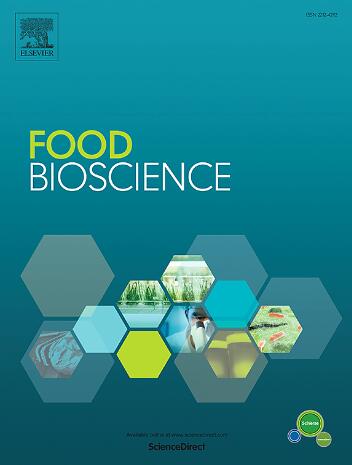葡萄糖和过氧化氢催化降解模型系统中氧化还原酶和过氧化氢酶活性的定量评估
IF 5.9
1区 农林科学
Q1 FOOD SCIENCE & TECHNOLOGY
引用次数: 0
摘要
该研究定量表征了在酸性模型溶液中通过葡萄糖氧化酶/过氧化氢酶(GO/CAT)酶系统去除葡萄糖的工艺参数。在pH值4.0-5.5和温度25 - 50℃范围内进行筛选,结果表明pH值5.5和40℃是氧化石墨烯的最佳选择,pH值5.0时氧化石墨烯的活性仅降低2.5%。在此条件下,过氧化氢酶保持了86.5%的最大活性。溶解氧浓度是影响葡萄糖转化的关键因素。不加氧(初始溶解氧浓度为7.5-8.0 mg/L),反应6小时葡萄糖去除率为29.0%。额外的氧合(9.5-11.0 mg/L),使用1000 U的氧化石墨烯和不同的CAT活性(0,1000,3000,4500 U),使葡萄糖从初始葡萄糖浓度27 g/L分别减少2.9%,57.0%,75.9%和93.4%。在氧浓度为12.5-14.0 mg/L、氧化石墨烯浓度为1000 U、过氧化氢浓度为3000 U的条件下,葡萄糖在4小时内完全氧化。过氧化氢在pH为5.5/40℃时对氧化石墨烯的抑制作用呈浓度依赖性,在45、60和75 mmol/L H2O2条件下的相对活性分别为82.6%、80%和70.4%。热稳定性评估显示,氧化石墨烯在6 h后仍保持90.4%的活性,而CAT则保持96.9%。巴氏灭菌(90°C, 10分钟)完全灭活氧化石墨烯,导致CAT活性损失84.9%。这些发现建立了实用的操作指南-在微酸性pH条件和高温条件下,GO:CAT≥1:3和氧浓度>;9.5 mg/L用于有效的葡萄糖消耗。本文章由计算机程序翻译,如有差异,请以英文原文为准。

Quantitative assessment of oxidoreductase and catalase enzymatic activity in model systems for catalyzed degradation of glucose and hydrogen peroxide
The study quantitatively characterizes the process parameters that enable glucose removal via the glucose oxidase/catalase (GO/CAT) enzymatic system in acidic model solutions. Screening across a pH range of 4.0–5.5 and temperatures from 25 to 50 °C identified pH 5.5 and 40 °C as optimal for GO, with activity at pH 5.0 reduced by only 2.5 %. Under these conditions, catalase retained 86.5 % of its maximal activity. Dissolved oxygen concentration was found to be a key factor that impacts glucose conversion. Without oxygenation (initial dissolved oxygen concentration of 7.5–8.0 mg/L), 6-h reactions achieved 29.0 % glucose removal. Additional oxygenation (9.5–11.0 mg/L), using 1000 U GO with varying CAT activities (0, 1000, 3000, 4500 U), yielded glucose reductions of 2.9 %, 57.0 %, 75.9 %, and 93.4 %, respectively, from an initial glucose concentration of 27 g/L. At an oxygen concentration of 12.5–14.0 mg/L with 1000 U GO and 3000 U CAT, complete glucose oxidation was achieved within 4 h. Hydrogen peroxide exhibited concentration-dependent inhibition of GO at pH 5.5/40 °C, with relative activities of 82.6 %, 80 %, and 70.4 % at 45, 60, and 75 mmol/L H2O2, respectively. Thermal stability assessment revealed that GO retained 90.4 % of its activity after 6 h, whereas CAT retained 96.9 %. Pasteurization (90 °C, 10 min) fully inactivated GO and caused 84.9 % loss of CAT activity. These findings establish practical operational guidelines — GO:CAT ≥1:3 and oxygen concentration >9.5 mg/L for efficient glucose depletion under slightly acidic pH conditions and elevated temperature conditions.
求助全文
通过发布文献求助,成功后即可免费获取论文全文。
去求助
来源期刊

Food Bioscience
Biochemistry, Genetics and Molecular Biology-Biochemistry
CiteScore
6.40
自引率
5.80%
发文量
671
审稿时长
27 days
期刊介绍:
Food Bioscience is a peer-reviewed journal that aims to provide a forum for recent developments in the field of bio-related food research. The journal focuses on both fundamental and applied research worldwide, with special attention to ethnic and cultural aspects of food bioresearch.
 求助内容:
求助内容: 应助结果提醒方式:
应助结果提醒方式:


